All-Cause Mortality by Vaccination Status
Analysis of United Kingdom Office for National Statistics Data
The United Kingdom’s Office for National Statistics “the UK’s largest independent producer of official statistics and its recognised national statistical institute” has quietly released substantial data on the COVID-19 vaccines.
Despite containing some of the most detailed breakdowns of the relationship between the COVID-19 vaccines and mortality available, it has gone almost unnoticed.
I will try to present this data here using easily understood and transparent methods. I am not a professional. I encourage anyone reading this to verify the data and methods themselves. My goal is to get the attention of professionals so they can analyze this data using their expertise, and in a more public manner than this. There is always the possibility of a confounding variable or error.
All that said, the official UK Government data indicates substantially increased mortality rates in many individuals vaccinated with the COVID-19 vaccines, over the unvaccinated.
Table 1 of the dataset, “Monthly age-standardised mortality rates by vaccination status for all deaths, deaths involving COVID-19 and deaths not involving COVID-19, per 100,000 person-years, England; deaths occurring between 1 January 2021 and 31 January 2022”, looks as follows.
The significant column is “age-standardised mortality rate / 100,000 person years”. It is age standardized to minimize statistical problems with different amounts of vaccine uptake in different age brackets (more on that shortly). The number was calculated using person years, so it can be understood as the expected number of deaths yearly per 100,000 population within the appropriate category.
There is data in this document for all-cause, COVID-19, and non-COVID-19 deaths. Looking at all cause deaths shows if vaccines are having a net positive or negative effect, so that is what we will do. As an extreme example if per 100,000 people vaccines killed 999 from adverse events, but saved 1000 from COVID-19, the vaccinated group still would have a lower all cause mortality rate than the unvaccinated.
If the January rate charted above held for a year, we would expect:
2502.9 deaths over the year per 100,000 unvaccinated
1,330.1 deaths over the year per 100,000 with 1 dose less than 21 days ago
1,718.5 deaths over the year per 100,000 with 1 dose at least 21 days ago
265.6 deaths over the year per 100,000 with 2 doses less than 21 days ago
166.1 deaths over the year per 100,000 with 2 doses at least 21 days ago
This is the effect nearly everyone expects the COVID-19 vaccines to have. The data shows an over 90% reduction in mortality rate for those who took 2 doses at least 21 days ago. Keep in mind these are all-cause deaths. At the time there was a substantial likelihood COVID-19 would have been the expected cause of death, for any unvaccinated deaths.
That was the earliest data in the set, January 2021. Now look at the chart of latest data in the set, January 2022.
The all-cause mortality rate is substantially higher in those with 1 or 2 doses than those unvaccinated. That does not seem like it could possibly be correct. Was it just some type of year end accounting artifact?
Lets plot the entire dataset as a timeline.
As we know in January 2021, those vaccinated with 1 and 2 doses have lower mortality rates than unvaccinated. But then in May 2021 those vaccinated with 1 dose ‘at least 21 days ago’, start to have a higher mortality rate than unvaccinated. In October 2021, those vaccinated with 2 doses ‘at least 6 months ago’ start to have a higher mortality rate than unvaccinated. They are followed in November 2021 by those with 2 doses ‘at least 21 days ago’. In addition, the mortality rate of those vaccinated with 3 doses is consistently getting closer to that of unvaccinated. All these trends continue through the end of the dataset in January 2022.
This clearly isn’t an accounting issue, so the obvious variable to look at is age. Even though the Office for National Statistics says its data is age standardized, the data must not account for age in a manner that shows what is really happening.
Table 2 has exactly what you need to look at this more closely. The same mortality by vaccination status data is broken down into age bands of 18-39, 40-49, 50-59, 60-69, 70-79, 80-89, and 90+. I charted it the same way as above, but I removed the ‘less than 21 days ago’ categories as they add a lot of noise and people will be in those groups only a short time compared to the ‘at least 21 days ago’ categories. Additionally the Office for National Statistics combined the ‘between 21 days and 6 months ago’ category with ‘at least 6 months ago’.
This data shows a few interesting things. First that the effect seems to be real and consistent. Second that the effect occurs progressively later as age groups get younger. Third that in ages 18-39 the vaccine seems to have had a negative effect from the start.
I would like to display all the above data in one chart, but the mortality rates are wildly different with 90,000 being the peak for 90+ while 120 is the peak for 18-39. For this reasons the data must be standardized first, which I do as ‘rate vs unvaccinated’.
For example, in January the 18-39 mortality rate of 120 for 1 dose vs 60 for unvaccinated, could be displayed as the 1 dose rate being 2x the unvaccinated rate. For 90+ the 30,000 rate for 1 dose vs 60,000 rate for unvaccinated, could be displayed as the 1 dose rate being 0.5x the unvaccinated rate. When the data is organized in that way and combined, you get the following chart.
This data is all very alarming. A poorly functioning vaccine should still have at least a small positive effect. A non-functioning vaccine should have no effect. Yet we see a negative effect in all age groups for both 1 or 2 doses taken ‘at least 21 days ago’, and it is most cases the negative effect is quite large. The fact that the pattern is consistent and predictable, meaning it moves smoothly from month to month and age bracket to age bracket, gives even more credibility to the pattern.
As I have said, I am not an expert, and there is always the possibility of a reasonable explanation. However since there is potentially a health concern that the data indicates may be larger than COVID-19 itself, it deserves immediate further analysis in a transparent and public way.
Please help get this in front of the right people.



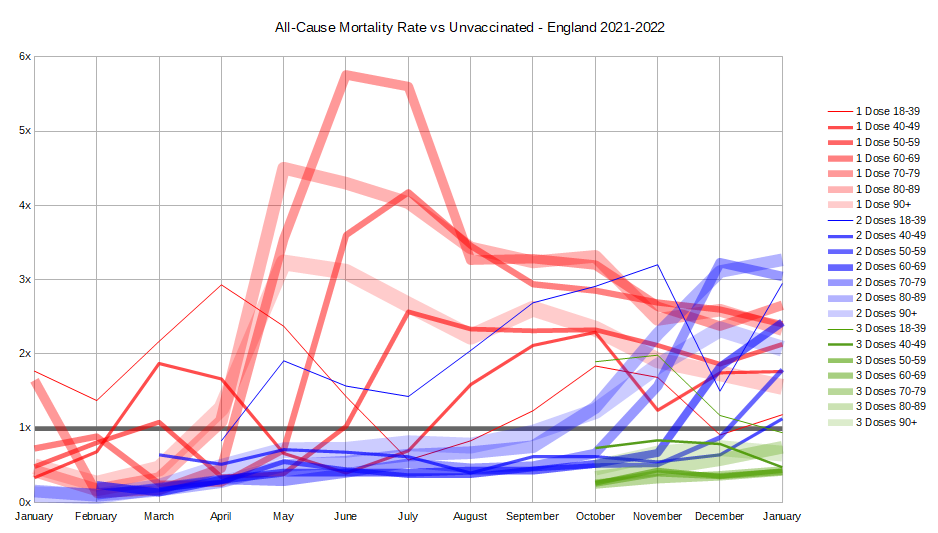
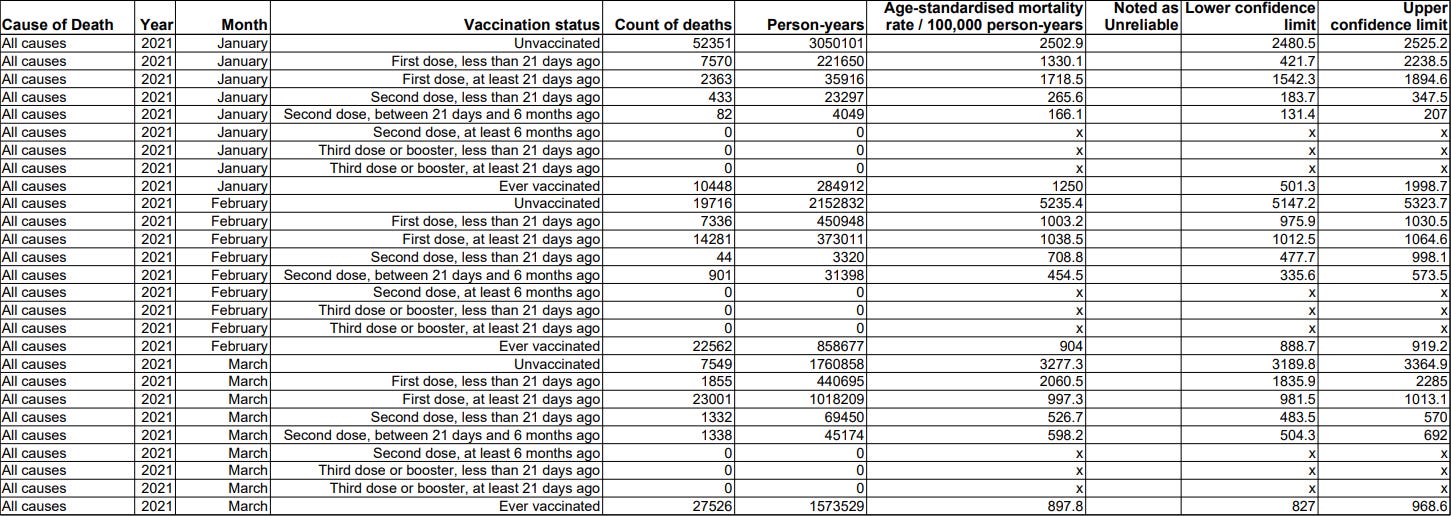
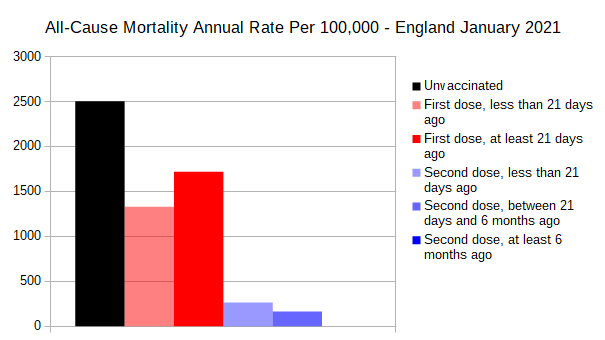


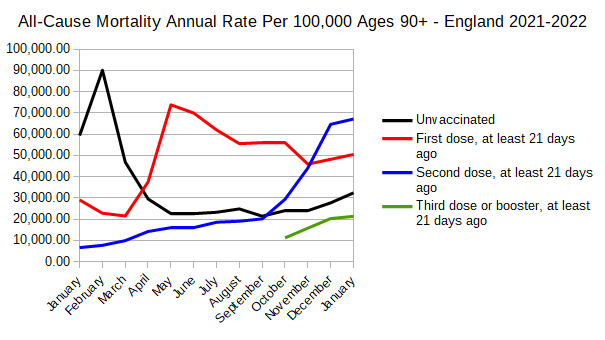






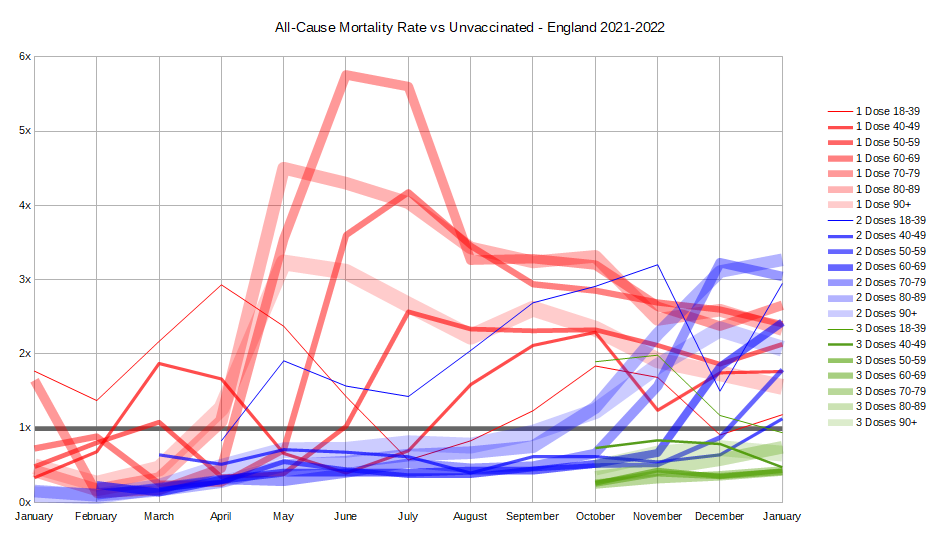
Nice work. I've added this article to my article at https://stevekirsch.substack.com/p/uk-government-data-shows-nobody-should?s=w can you have a look at what I did?
As I said below, the mortality spike in Jan 2021 in the 70+ cohort among the unvaccinated either means 1) "unvaccinated" includes those within 14 days of their first jab or 2) that group was too ill to be vaccinated. I remember at the time all of the reports about nursing home deaths following the vaccination campaigns, so the January 2021 data among the 70+ either have huge confounders, or they are manipulated. It has been shown by many others that "unvaccinated" includes those receiving their first jab, but less than 14 days ago (or in this case, most likely 21 days ago). That issue cannot be resolved from the data provided -- if the data themselves are lies, then you can't distinguish anything. But the long term data (months after the most recent jab) show an alarming signal, as you say. Those cannot be gamed in the same way.